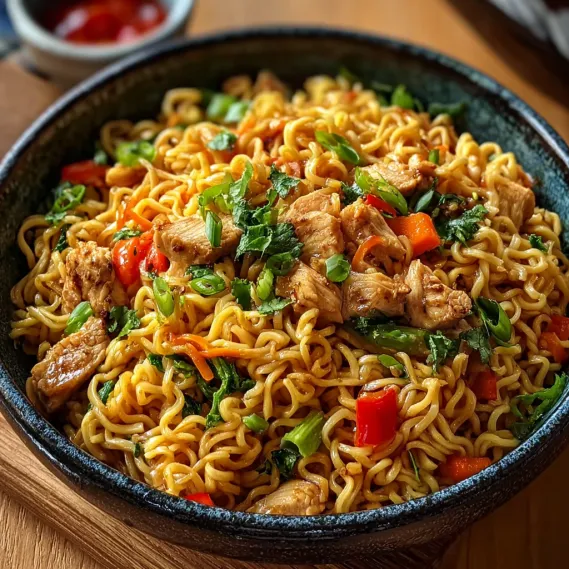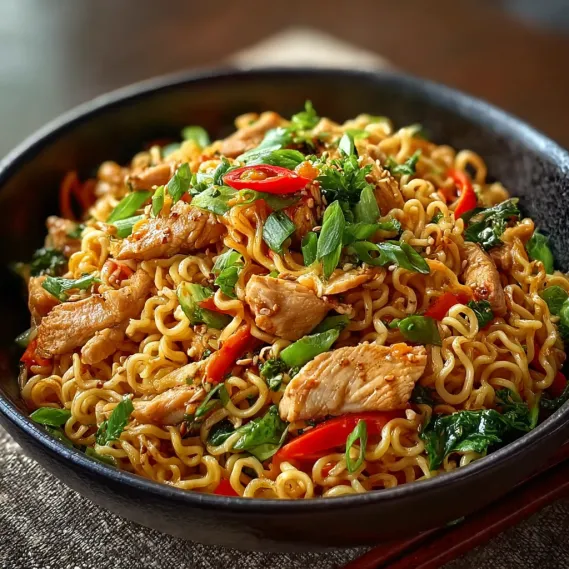 Pin
Pin
This hearty Chicken Ramen Stir Fry has transformed my weeknight dinner routine, taking humble ramen noodles to extraordinary heights with minimal effort. The savory sauce clings perfectly to the tender chicken and vegetables, creating a restaurant-quality meal from your own kitchen.
I first created this recipe during a particularly busy semester of grad school, when time and money were equally scarce. What began as a desperate pantry raid has since become our family's most requested dinner, especially when time is tight but cravings are strong.
Ingredients
- Ramen noodles: discarded seasoning packets provide the perfect chewy texture and absorb the homemade sauce beautifully
- Chicken thighs: offer more flavor and tenderness than breast meat and stay juicy even if slightly overcooked
- Red bell pepper: adds vibrant color and sweet crunch to balance the savory elements
- Snap peas: provide fresh texture and bright green color that pops in the final dish
- Carrots: add natural sweetness and another layer of texture when julienned thinly
- Garlic and ginger: form the aromatic base that gives this dish its authentic Asian flavor profile
- Green onions: provide two distinct flavors when separated white parts cook into the dish while green tops add fresh finish
- Soy sauce: creates the savory umami foundation for the sauce
- Oyster sauce: adds complex sweetness and body to the sauce without being overpowering
- Sesame oil: brings nutty depth and authentic flavor with just a small amount
- Sugar: balances the saltiness of the soy and oyster sauces
- White pepper: adds subtle heat that complements Asian flavors better than black pepper
Step-by-Step Instructions
- Prep Noodles and Sauce:
- Begin by bringing a large pot of water to a rolling boil for your ramen. While waiting, whisk together your sauce ingredients in a small bowl until the sugar fully dissolves. This sauce preparation allows the flavors to meld while you continue cooking.
- Cook the Chicken:
- Heat your wok until it just starts smoking before adding oil. This ensures proper searing rather than steaming. Add your chicken pieces in a single layer without overcrowding and let them develop a golden crust before stirring. Cook until no pink remains but avoid overcooking which can make them tough.
- Stir Fry the Vegetables:
- Using the same pan captures all the flavorful chicken bits. Add your vegetables in order of cooking time with harder vegetables first. The key is maintaining high heat and quick movement to achieve that perfect crisp tender texture where vegetables retain their vibrant color and slight crunch.
- Create the Aromatic Base:
- Adding garlic, ginger, and white parts of green onions at this later stage prevents burning while still releasing their essential oils and fragrance. Cook only until you can smell their aroma wafting up from the pan, usually 30 seconds is sufficient.
- Cook and Drain Noodles:
- Slightly undercooking the ramen is crucial as they'll continue cooking when added to the hot stir fry. Drain thoroughly to prevent a watery sauce. Shaking the colander several times helps remove excess water hiding between the noodles.
- Combine and Finish:
- Return everything to the pan and pour the sauce evenly over all ingredients. Use tongs or two spatulas to gently lift and fold the ingredients rather than stirring, which can break the noodles. The sauce should coat everything evenly and thicken slightly from the heat.

The ginger in this recipe completely transforms the dish. I learned from my Chinese neighbor that freezing fresh ginger makes it infinitely easier to grate and extends its shelf life for months. Now I always keep a knob in my freezer specifically for stir fries like this one.
Make Ahead and Storage
This dish keeps beautifully for up to 3 days in the refrigerator, with flavors actually improving overnight as the sauce permeates the ingredients. Store in airtight containers and reheat in a skillet with a splash of water to revive the noodles. The texture stays remarkably good compared to other noodle dishes that can become mushy when stored.
Easy Substitutions
This recipe welcomes endless variations based on what you have available. Beef, pork, shrimp, or tofu can replace the chicken. Any vegetables work well broccoli, mushrooms, zucchini, or spinach are all excellent additions. For gluten free needs, rice noodles can substitute for ramen, though cooking times will vary. Tamari can replace soy sauce, and hoisin sauce works in place of oyster sauce for a vegetarian version.
Serving Suggestions
Serve this vibrant stir fry in deep bowls for the best eating experience. A sprinkle of sesame seeds adds visual appeal and subtle crunch. For a complete meal, no sides are necessary, but a simple cucumber salad with rice vinegar makes a refreshing contrast to the rich flavors. For heat lovers, serve with sriracha or chili oil on the side to customize individual spice preferences.
The Humble Origins
This dish represents the creative evolution of instant ramen, which was invented in post WWII Japan when food shortages were common. What began as an inexpensive convenience food has transformed into a versatile ingredient embraced by home cooks and chefs alike. This particular recipe honors those practical origins while elevating the humble noodle with fresh ingredients and authentic Asian cooking techniques.
Common Questions About This Recipe
- → Can I use chicken breast instead of thighs?
Yes, chicken breast can be used, though thighs tend to remain juicier. Just be careful not to overcook breast pieces as they can dry out more quickly than thighs.
- → What vegetables can I substitute?
Feel free to swap in broccoli, snow peas, mushrooms, or zucchini for variety. Just adjust cooking times to keep vegetables crisp-tender.
- → Is it necessary to discard ramen seasoning packets?
Yes, discard the included seasoning packets, as this dish uses a homemade sauce for balanced flavor without extra sodium.
- → How do I prevent the noodles from getting mushy?
Cook ramen noodles for less than the package time—just until barely tender—since they will finish cooking in the stir-fry.
- → Can this dish be made ahead?
It's best enjoyed fresh, but leftovers can be refrigerated and reheated. The noodles may absorb some sauce, so add a splash of water when reheating.
